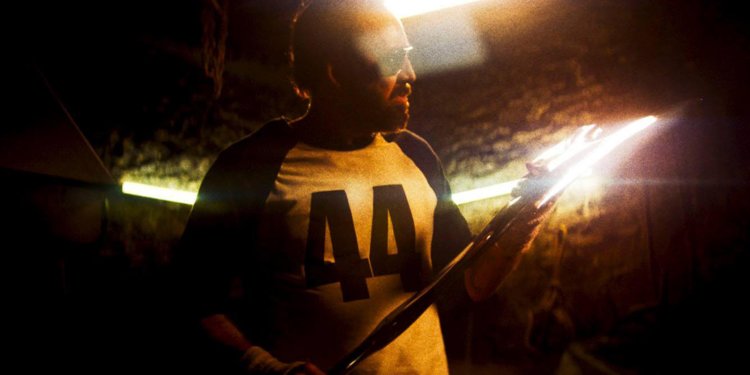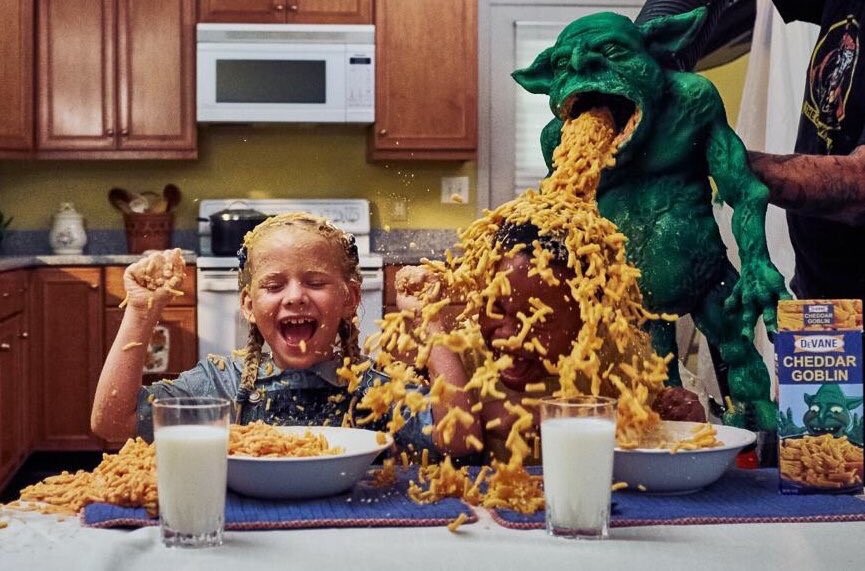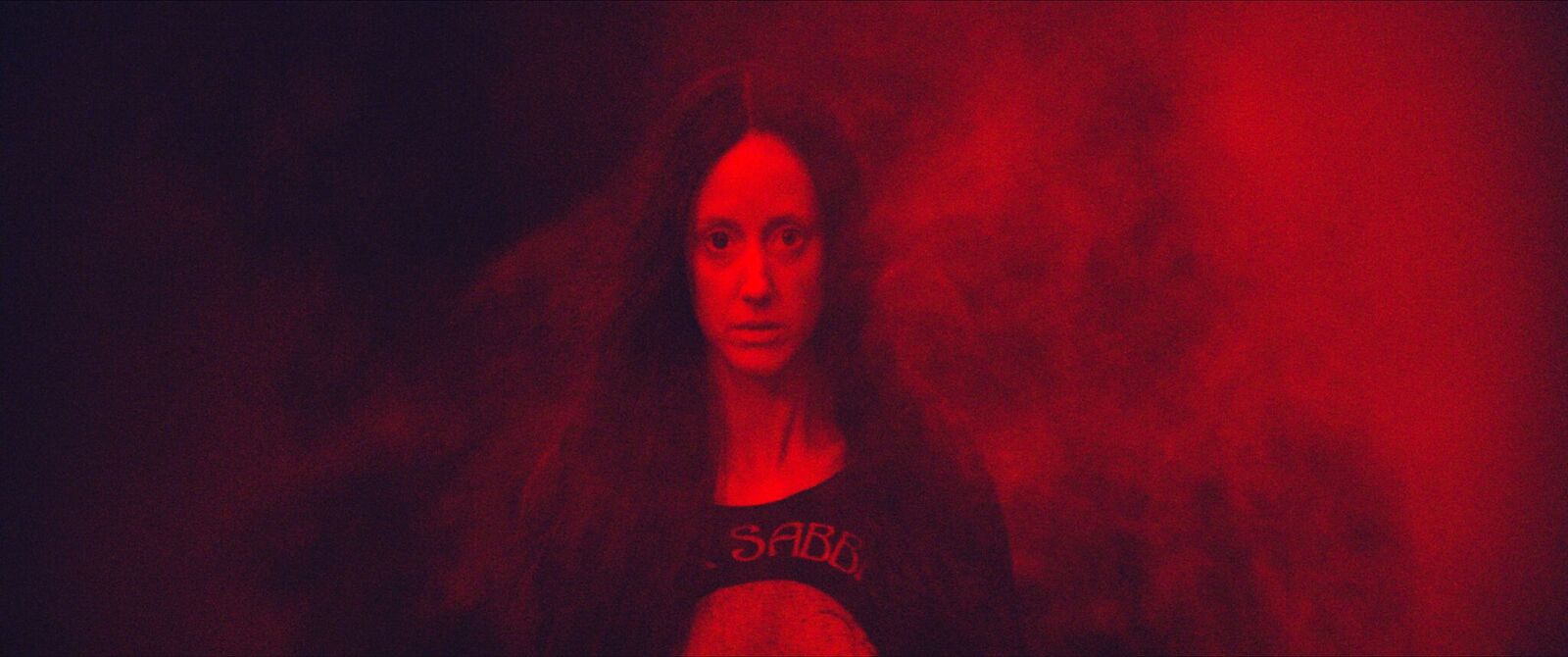
Panos Cosmatos‘ Mandy was released last week, streaming on most VOD services, and enjoying a brief foray into theaters. From the first moment the trailer hit, to the announcement that star Nicolas Cage was involved (and instructed to do his wacky best), the excitement was palpable. Sitting in a packed theater at New York City’s IFC Center on Thursday, Sept. 13, it seemed that excitement was contagious. A bit later than expected, the film started, and by the end…I wish that film had lived up to the excitement. Don’t get me wrong; I did enjoy Mandy — just not the way it seems others online have enjoyed it…
Set in the Pacific Northwest in 1983, Nicolas Cage stars as Red, a humble lumberjack living a quiet life with his wife Mandy (Andrea Riseborough). We briefly get to know these two (she’s an artist, apparently), before their quiet home is beset by the Manson-esque cult of Jeremiah Sand (Linus Roache), who offer Mandy and Red as sacrifices to leather-garbed demon-esque biker gang that travel across the land. Mandy is brutally murdered, Red incapacitated and forced to watch, and Sand and his family move on, leaving Red to die. Escaping, Red fashions some weapons before exacting bloody revenge for his wife. None of this spoils the movie per se; the plot is as straightforward as it can be, but it is stylistically unique. This is a movie that is the epitome of style over substance, both to to its benefit and detriment.
There is a scene halfway through the film where Red goes to the trailer of Carruthers (Bill Duke), in search of his trusty crossbow, and subsequently forges a bad-ass heavy metal battle ax (he does this…somewhere). Carruthers gives a brief history of the Sand cult, as well as the demonic biker gang, and then we never see or hear from him again. Prior to this scene and his introduction, Mandy is beautifully paced: while the home life of Mandy and red is brief, we get enough of an idea of who they are together (although we don’t get too much information about who they are as individuals; as a result, Mandy’s death hits less hard than it would, although she’s treated more as a plot device to begin with from the get go); the first half wafts in a dreamlike state; with deep colors that often bleed from one scene to another.
The entire sequence wherein Sand drugs and tries to recruit Mandy into his cult is remarkably done; Linus Roache is given a hell of a character to play here (a role that was initially offered to Cage, if you could believe it), and gives a near five minute monologue of unhinged ranting. Shot in close-up, the scene alternates between Roache’s face and Riseborough’s, dissolving so subtly back and forth it took two transitions before I’d even noticed what was happening, and that the transition was being done. The entire first half is so deliberately and beautifully paced it is jarring in comparison to the second half.

Following Red constructing his battle ax, he goes after the demonic biker gang, and plows his bloody way through Sand’s cult, before confronting Sand himself. Impalings occur, heads are lopped off, and there’s a chainsaw fight. It’s awesome, yes, but over a bit too quick (Red takes care of the demon bikers with near incredible ease, and three of Sand’s cult members are dispatched without even putting up a fight at all; one of the three demon bikers is stabbed with his own hand/knife, but the sequence is so oddly edited I just assumed he’d stabbed himself). Cage goes for broke here, displaying the same gonzo energy he’d used to great effect in Mom & Dad, but it, oddly, seemed out of place here. Look, I love Crazy Cage; I think Mom & Dad is the best example of Cage going for broke (although that film as a whole doesn’t quite work), and I think Vampire’s Kiss shows a derangement that I wish were utilized much more often.
With Mandy, following the brilliantly-paced and photographed first half, the gonzo energy of the second half seems, strangely, misplaced. There’s little effort to segue into crazytown; it just sort of happens, with little regard for the character development that took place within the first forty or so minutes of the film. It felt like the scenes prior to Carruthers appearing, and the scenes after Carruthers appeared are from two wholly different movies; yes, I would absolutely want to see both movies, but together, it doesn’t work as smoothly as I’d hoped.
From the trailers, one would expected the entire film would exploit Crazy Cage and be a manic gonzo rush; however, strangely enough, the deliberate pace of the first two acts undercuts the last act. I’d want either an entire film of acid dream, or an entire film of Crazy Homicide Cage. And for a film to gain an actor like Bill Duke, and not do anything more with him is baffling. And I’m not sure whether the sound mixing was off, or the IFC Center needs an upgrade, but there were a few instances of the dialogue being WAY too low to clearly hear.
The score by the late Johann Johannsson is near-constant, moody, and industrial, eliciting a near endless sense of foreboding. As always, his score is fantastic, furthering director Cosmatos’ declaration that Mandy is, essentially, a prog-rock heavy metal opera. Benjamin Loeb‘s cinematography is absolutely gorgeous. Any single frame of this film could be framed on a wall, or set in a modern art gallery. The elevated colors and and sleek shot composition is riveting, and the entire climactic confrontation with Sand’s cult is a masterwork in using light to set mood.

However, a lot of that was lost on the audience: for some reason, every single sequence where Nicolas Cage did anything elicited giggles or guffaws, most bafflingly when Red drinks away his sorrow after Mandy is burned alive. He is in the throes of sorrow, and breaking down, in shock, and somehow this is the most hilarious sequence to several people sitting around me. So confused was I that I actually turned to the random guy sitting to my left, and we each gave a “Did I miss something?” look. Nicolas Cage is a great actor, as well as a crazy one, and there’s a time and a place, but laughing at a scene where nothing funny is occurring doesn’t magically make the scene funny.
But I digress…
Mandy is a beautiful, infuriating, glorious film that is so close to being great it’s annoying. I wanted to be as in love with this film as so many others seem to be, but can’t get past the feeling that I was watching two separate films. But maybe you’ll get more out of it than I did. I hope you do. And I hope you watch it with a better audience than I did. 3/5 Cheddar Goblins.
-J.L. Caraballo



